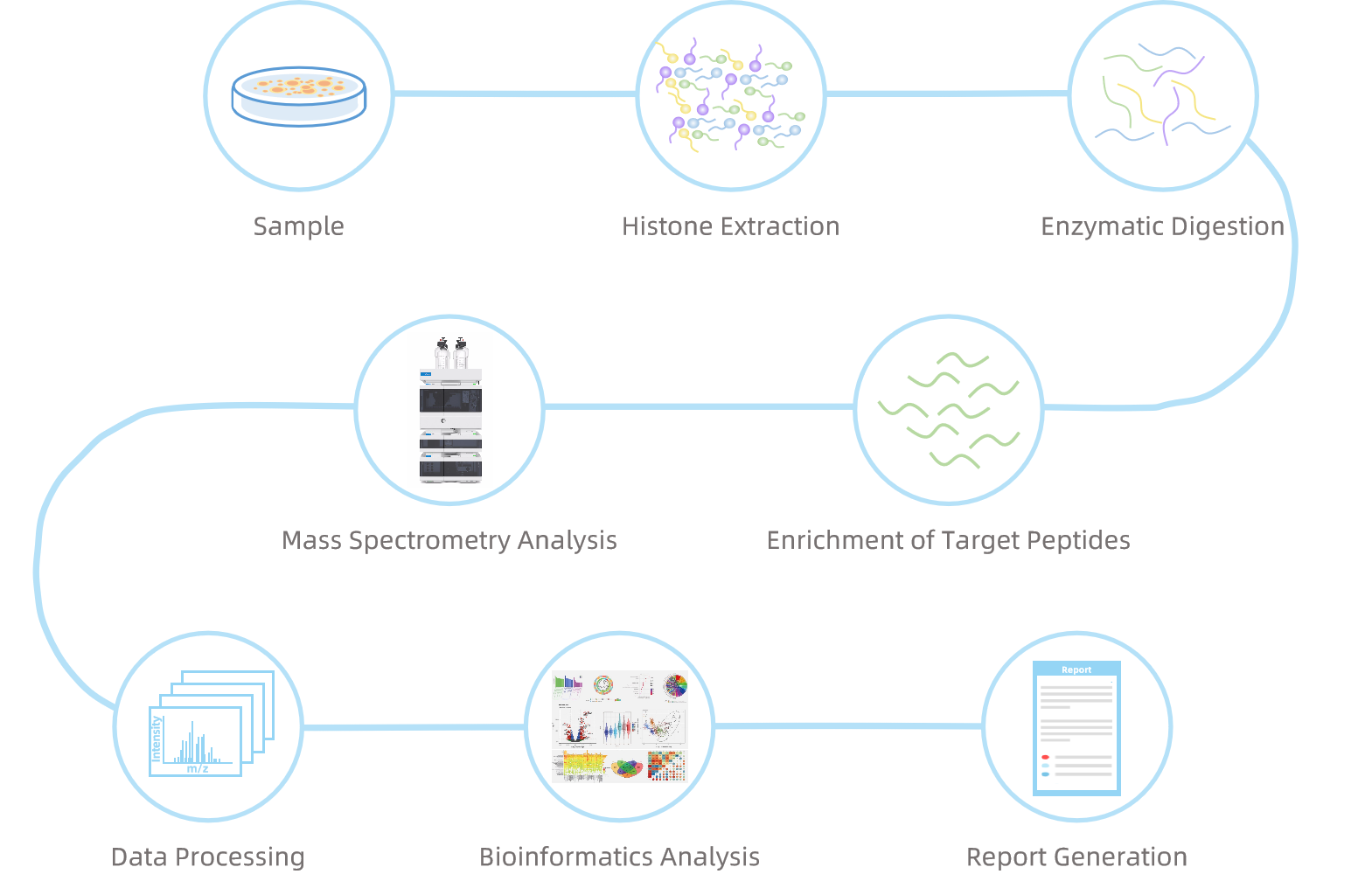Histone β-Hydroxybutyrylation Analysis
- Animal tissue ≥ 2 g
- Plant tissue ≥ 0.4 g
- Serum / Plasma ≥ 2 mL (plasma should be collected using EDTA as an anticoagulant)
- Urine ≥ 10 mL
- Cell ≥ 1 x 10⁸ cells
- Yeast / Microbial samples ≥ 0.4 g
- Protein samples: 2-5 mg (Standard tissue or cell lysis buffers can be used during protein extraction)
Histone β-hydroxybutyrylation is a prevalent post-translational modification found on lysine residues of histones, originating from β-hydroxybutyrate (β-HB), one of the key metabolites associated with ketone metabolism. This modification has garnered significant attention due to its critical role in regulating gene expression and its implications in various biological processes.
Research has found that interventions such as calorie restriction, ketogenic diets, and high-intensity exercise can increase the production of β-HB, which is positively correlated with muscle mass and declines with age. β-HB protects skeletal muscle through histone β-hydroxybutyrylation (Kbhb) modifications, regulating gene expression, enhancing the expression of mitochondrial-related genes, and improving mitochondrial function. Inhibition of histone Kbhb eliminates the protective effects of β-HB against sarcopenia. These findings suggest that targeting β-HB production and/or Kbhb could serve as a potential therapeutic strategy for age-related sarcopenia, particularly for elderly individuals who are unable to engage in physical activity.
Services at MtoZ Biolabs
MtoZ Biolabs utilizes Thermo Fisher's Q Exactive HF, Orbitrap Fusion, and Orbitrap Fusion Lumos mass spectrometry platforms, in combination with Nano-LC, to provide a comprehensive solution for histone β-hydroxybutyrylation analysis. Simply provide your experimental objectives and send us your samples, and we will offer you a one-stop service from sample preparation and MS analysis to data analysis, delivering detailed identification and quantitative analysis of histone β-hydroxybutyrylation modifications and their modification sites.
Compared to traditional proteomics analysis, the key to histone modification analysis lies in the isolation and purification of histone components, as well as mitigating the impact of N-terminal lysine on the analysis of histone post-translational modifications. Since histones are located in the cell nucleus, MtoZ Biolabs has developed a specialized platform for histone extraction and purification, drawing on existing literature and experimental experience. Cells are homogenized and subjected to low-speed centrifugation to obtain the nuclei. The nuclei are then further disrupted to release histones and DNA. High-salt buffer is used to remove impurities, and High-Performance Liquid Chromatography (HPLC) is employed to separate different histone components, achieving optimal purity for subsequent mass spectrometry analyses. Additionally, to eliminate the impact of N-terminal lysine, we utilize 2-3 different enzymes to enhance peptide coverage in mass spectrometry analysis during the digestion process. This multi-enzymatic digestion increases the coverage of histone peptides, preventing the loss of post-translational modification information due to unsuitable peptide lengths or low ionization efficiency.
Analysis Workflow

Service Advantages
1. Advance Analysis Platform
Mtoz Biolabs established an advanced histone β-hydroxybutyrylation analysis platform, guaranteeing reliable, fast, and highly accurate analysis service.
2. One-Time-Charge
Our pricing is transparent, no hidden fees or additional costs.
3. High-Data-Quality
Deep data coverage with strict data quality control. AI-powered bioinformatics platform integrate all histone β-hydroxybutyrylation analysis data providing clients with acomprehensive data report.
4. Optimized Extraction
An optimized histone extraction and purification protocols are employed to minimize contamination and ensure high purity.
Sample Submission Requirements
1. Sample Volume
2. Sample Preservation
Samples should be shipped with dry ice. Avoid repeated cycles of freezing and thawing
Note: We will conduct testing on the provided samples. The formal experiment will commence only after the samples pass the quality check.
Deliverables
1. Comprehensive Experimental Details (Materials, Instruments, and Methods, etc.)
2. Relevant Liquid Chromatography and Mass Spectrometry Parameters
3. Detailed Information on Histone β-Hydroxybutyrylation Analysis
4. Raw Data
5. Mass Spectrometry Image
6. Custom Analysis Report
MtoZ Biolabs employs advanced mass spectrometry platforms for histone β-hydroxybutyrylation analysis services. Our goal is to provide you with accurate and reliable results to facilitate your research and product development projects. Contact us now to learn more about how we can assist you.
MtoZ Biolabs, an integrated chromatography and mass spectrometry (MS) services provider.
Related Services
Histone Post-Translational Modification Analysis Service
How to order?







